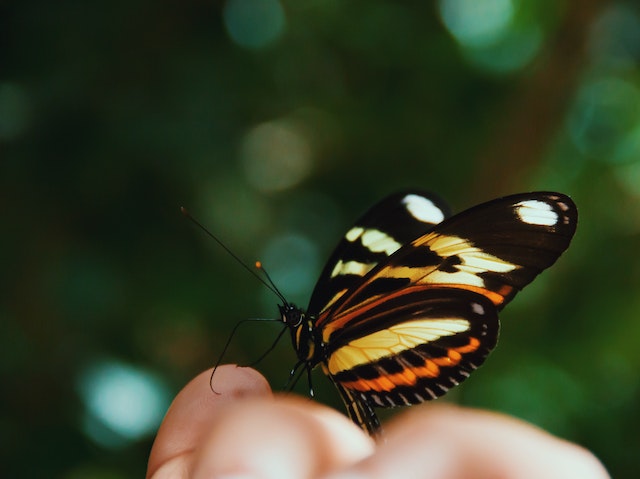
What is the difference between a moth and a butterfly? Amongst other things, their wings, their bodies, how they behave, and how they pupate.
Butterflies and moths both belong to the Lepidoptera family. Lepidoptera is a huge insect family and it contains 180,000 insects, which is approximately 10% of all living organisms. Inside that family, there are 17,500 species of butterfly and 160,000 species of moths. Lepidoptera comes from the Greek “lepis”, which means scale and “pteron”, which means wing. Both moths and butterflies are covered in tiny scales. If you touch a butterfly’s wing and get a fine powder on your fingers, that is some of the scales. They fall off and regrow constantly.
The largest butterfly in the world is the Queen Alexandra’s birdwing, which has a wingspan of 27 cm, 11 inches. The smallest butterfly is the Western Pygmy Blue, which has a wingspan of 1.25 cm, 0.5 inches. The largest moth is the Atlas moth, which has a wingspan of 27 cm, the same as the Queen Alexandra’s birdwing, and the smallest moth is the Stigmella maya, which has a wingspan of 1.2 mm, 0.01 inches.
Because there are so many different species of moth, it is hard to clearly talk about the differences between moths and butterflies, but here are some of the main ones. Butterflies and moths are active at different times of the day. Butterflies are diurnal, which means they are active during the day, and moths are generally nocturnal, which means they are active at night. There are always exceptions to the rule and there are some moths that are diurnal and some butterflies that are nocturnal.
Butterflies and moths tend to be different colors. Butterflies are usually bright and vivid, while moths tend to be dull and plainer. This is because of the times they are active. Butterflies fly around in the daylight and they need to blend in with the bright colored flowers, or look like other kinds of animals. Moths are active at night, where colors are not so important. Moths tend to be shades of grey or brown, that will help them blend in in the dark.
Butterflies and moths have different antennae as well. Butterflies have club-shaped antennae that have a long shaft and a bulb at the end. Moths have simple antennae that are feathery. They both use their antennae for similar purposes. The antennae have lots of sensors on the ends that are highly attuned to odors. They are so good that butterflies can tell if a flower has nectar in it before they even land.
They have different wings as well. Moth wings are linked together by a structure in the middle called a frenulum. Butterfly wings are not connected and they can flap them independently. This helps them when they make sharp turns. Another difference can be seen when they are at rest. Butterflies hold their wings together above their body when they are not flying. Moths usually hold their wings flat.
Another difference is in the way that they pupate. Both butterflies and moths start life as an egg, which then becomes a caterpillar. There are some differences between butterflies and moths even at the caterpillar stage. If a caterpillar is fuzzy or hairy then it is a moth. If a caterpillar is spikey, it is a butterfly. However, if the caterpillar is smooth, it could be either a butterfly or a moth. The caterpillar’s job is to eat as much as possible so that it has enough material to become a butterfly or a caterpillar. When they transform, they wrap themselves up, turn into a jelly, and then turn into a moth or a butterfly. How they do that is slightly different. Butterflies make a chrysalis, which is a smooth, hard covering. Butterfly caterpillars usually attach themselves to a branch. The chrysalis forms inside them and is another exoskeleton. Their outer skin falls off, leaving the chrysalis case. Moths create a cocoon and they usually hide before they make it, in places such as under rocks or under leaves. They have a spinnerette near their mouth which produces silk, similar to a spider. A liquid comes out of this mouth and hardens when it comes into contact with air. The moth caterpillar wraps itself in this and then starts to pupate.
These are some of the differences between butterflies and moths, but there are many exceptions to each one. And this is what I learned today.
Photo by Rafael Guimarães: https://www.pexels.com/photo/macro-photography-of-beige-orange-white-and-black-butterfly-on-human-hand-1060789/
Sources
https://meadowia.com/how-do-caterpillars-make-a-cocoon/
https://www.english-online.at/biology/butterflies/butterflies-and-moths.htm
https://animals.mom.com/purposes-butterfly-antennae-5431.html
https://www.si.edu/spotlight/buginfo/moths
https://www.si.edu/spotlight/buginfo/butterfly
